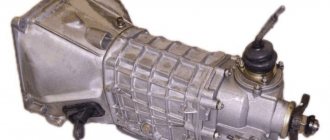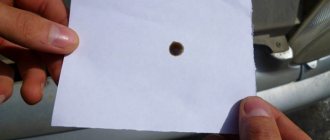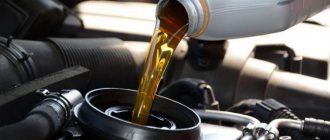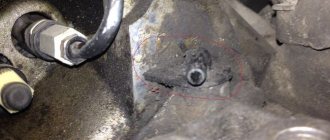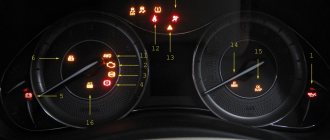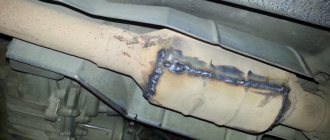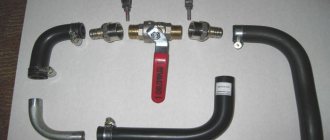06 March 2020 Lada.Online 93 795 66
Oil consumption is provided for by the engine design and cannot be equal to zero, otherwise the engine will be destroyed. At AvtoVAZ, there are standards for the consumption of motor oil, and the standards are the same for all VAZ engines (starting from the VAZ 21213 engine, which is installed on the Lada 4x4, ending with modern 1.6 and 1.8 liter VAZ 21126, VAZ-21129, VAZ-21179 engines). Let's figure out how much oil a VAZ engine should consume, as well as which of the AvtoVAZ engines is the most voracious.
Why is it burning oil? @Niva 4×4
At first glance, it looks like ordinary white smoke that happens in the morning.
5 main reasons why engines burn oil.
The main reasons for increased oil consumption are as follows: Broken piston rings 7. I’m thinking, is it worth getting into the engine, or driving it some more?
For some reason it eats synthetic oil... I just filled it in, but it doesn’t eat semi-synthetic oil.. LEONID TOKAEV on System fuses...
Worn or damaged valve oil seals 5. So I’m thinking, is it worth getting into the engine, or driving it some more?
One evening, or rather at night, I went to a kiosk for cigarettes, leaving my wife in the car so that she wouldn’t freeze, the car was running. In general, the next day the car is taken to a tow truck and to the service station. If the value of specific oil consumption is within acceptable limits, make a note in the service book indicating the protocol number and in the log of rejected complaints, give a second copy of the protocol to the owner.
I turned off the car, took out the dipstick - there were traces of emulsion, there were traces of oil in the expansion tank. In general, the next day the car is taken to a tow truck and to the service station.
We disassembled it, changed all the gaskets, ground the head, valve seals, rocker and camshaft. The engine was washed with oil twice.
It drives well, runs smoothly, although in cold minutes the speed doesn’t fluctuate much, I can’t find a normal IAC, then it returns to normal.
And not a liter per km. There are no leaks anywhere, the oil filter is apparently bad - the oil sensor blinks when it warms up.
I changed the sensor - no result. I was warned that the oil would eat up at first, but I've already driven 4 thousand.
Moreover, more than one master offers to drive thousands more, just change the oil and see if the oil consumption will decrease. The car does not smoke, compression is normal, I did not measure the oil pressure.
When it's cold, it emits bluish smoke, and you can see that it's bluish if you look closely. Car load: 2 people without cargo and additional roof rack. The test run should be carried out in controversial cases in the absence of obvious signs of increased oil consumption: The main reasons for increased oil consumption are the following: External oil leakage through oil seals, gaskets, seals.
The crankcase ventilation system is clogged 3. Coking of the slots in the oil scraper rings or grooves in the piston grooves due to the use of non-recommended oil 4. Worn or damaged valve oil seals 5.
diabloarea.ru NIVA SHEVA ENGINE
Increased wear of valve stems or guide bushings 6. Breakage of piston rings 7.
Abrasive wear of cylinders, piston rings, pistons, guide bushings in this case, the defect is eliminated at the expense of the owner. Wear of piston rings without wear of the cylinders, excessive thermal clearance of the rings, alignment of the ring locks in line, non-adhesion of the rings to the “mirror” of the cylinders, large clearance along the height of the rings in the piston grooves.
Fuel consumption. According to the passport and in reality.
According to the manufacturer’s technical documentation, gasoline consumption on a Niva 21213 carburetor is expressed in the following figures:
| Engine | Consumption (highway) | Consumption (city) | Consumption (mixed cycle) |
| 1.7 | 5 l/100 km | 9.6 l/100 km | 9.3 l/100 km |
The actual fuel consumption of the VAZ 21213 per 100 km will differ slightly from the declared one. This data depends on many factors. For example, in winter, fuel costs increase and reach 15-16 liters per hundred kilometers
. In summer, the figures drop to 10-12 liters. Increased fuel consumption is caused by poor condition of the carburetor and chassis of the VAZ.
The fuel consumption of the VAZ 21213 per 100 km is also influenced by the speed at which the car moves, the year of its manufacture and many other factors, from the condition of the road surface, the correct selection of car tires and their wear, to the driving experience of the driver himself. Off-road gasoline consumption on a VAZ 21213 carburetor, even a new one, will consume 20-30 liters of gasoline.
Where does the oil go in the internal combustion engine?
Where does the oil go in the internal combustion engine?
Post by DEKER » Feb 18, 2012, 11:04 pm
Re: Where does the oil in the internal combustion engine go?
Post by artem770 » Feb 18, 2012, 11:19 pm
Check the antifreeze and check all the leaks from the engine. Miracles don’t happen, the oil burns out or leaks out
[Posted from Niva-Club Mobile]
Re: Where does the oil in the internal combustion engine go?
Posted by doc Brown » Feb 18, 2012 11:47 pm
Re: Where does the oil go in an internal combustion engine?
Post by DEKER » 19 Feb 2012, 13:39
Re: Where does the oil go in an internal combustion engine?
Posted by doc Brown » 19 Feb 2012, 20:02
Re: Where does the oil go in an internal combustion engine?
Re: Where does the oil go in an internal combustion engine?
Post by serzh » Mar 28, 2012, 4:52 pm
Re: Where does the oil go in an internal combustion engine?
There is an oil leak from the engine, the entire camshaft drive cover is covered in oil, starting from the cylinder head cover.
There is also an oil leak in the area of the oil separator cover. Where to tighten? What kind of gaskets are there, rubber ones?
I changed the oil at 5000 km, now 8500 km, I had to add 0.5 liters.
Re: Where does the oil go in an internal combustion engine?
Post by Vovchik » 02 Apr 2012, 15:11
Re: Where does the oil go in an internal combustion engine?
Re: Where does the oil go in an internal combustion engine?
Post by Anton » April 02, 2012, 16:20
Re: Where does the oil go in an internal combustion engine?
Post by Vovchik » 02 Apr 2012, 17:48
Beware of the car In carb engines (1.6) on the front of the engine, oil appears from under: - the valve cover gasket (disposable gasket); — gaskets for the front cover of the engine block (usually after sloppy repairs); — front crankshaft oil seal (wear of the oil seal and/or pulley); — a loose chain guide bolt.
Considering that we are talking about an almost new car, the first point seems to me the most likely. There may be some other nuances in new engines
Trouble, trouble. The Niva began to flow.
Post by Stranger » April 17, 2012, 10:41 pm
It leaked from somewhere. It’s not clear where.
Help identify and advise how to eliminate
Even I spoke in poetry.
In the last photo - this is after 10 minutes of parking
Why is it burning oil? @Niva 4×4
At first glance, it looks like ordinary white smoke that happens in the morning.
5 main reasons why engines burn oil.
The main reasons for increased oil consumption are as follows: Broken piston rings 7. I’m thinking, is it worth getting into the engine, or driving it some more?
For some reason it eats synthetic oil... I just filled it in, but it doesn’t eat semi-synthetic oil.. LEONID TOKAEV on System fuses...
Worn or damaged valve oil seals 5. So I’m thinking, is it worth getting into the engine, or driving it some more?
One evening, or rather at night, I went to a kiosk for cigarettes, leaving my wife in the car so that she wouldn’t freeze, the car was running. In general, the next day the car is taken to a tow truck and to the service station. If the value of specific oil consumption is within acceptable limits, make a note in the service book indicating the protocol number and in the log of rejected complaints, give a second copy of the protocol to the owner.
I turned off the car, took out the dipstick - there were traces of emulsion, there were traces of oil in the expansion tank. In general, the next day the car is taken to a tow truck and to the service station.
We disassembled it, changed all the gaskets, ground the head, valve seals, rocker and camshaft. The engine was washed with oil twice.
It drives well, runs smoothly, although in cold minutes the speed doesn’t fluctuate much, I can’t find a normal IAC, then it returns to normal.
High oil consumption after overhaul in Niva 2123
VAZ (Lada) 2123 2000 - 2002
The engine has traveled 5000 km and has undergone major overhauls. The only thing we didn't do was go through the head, the valve seals were replaced, the valves were ground in well, the skirt was 1 mm, checked with kerosene. The valves do not swing. A little oil is thrown into the breather.
- Engine speed fluctuates at XX in Niva 2123 - 1 answer
- What is the name of the duralumin semicircle on the engine in Niva 2123? – 1 answer
Well what can I say. How big is it? How many per thousand? Well, this obviously cannot be called a major overhaul. Because that’s the concept of a major overhaul.
I imagine a major overhaul with troubleshooting all parts of the internal combustion engine, working with micrometers, replacing the ShPG, etc. Well, I don’t know how the repairs were carried out there. Well, there are many nuances why oil consumption will occur. So it’s like guessing from tea leaves here.
You write that the head was NOT touched, but according to the description of the issue, it turns out that it was the cylinder head that was serviced. Apparently no other work was done? If so, then it’s clear that the piston rings are worn out - the engine is eating oil. Of course, pressure is created in the crankcase from the gases that have penetrated, hence “oil is thrown into the breather.” Be sure to measure the compression in the cylinders and tell us - this will be clear information.
- Power steering hum in Honda SRV 3 – 2 answers
- How to bleed ABS brakes on a Honda SRV 3? – 1 answer
- Is flushing necessary when changing the oil in a Honda SRV 3 engine? – 2 answers
- What is the price of shock absorbers for Honda SRV 3? – 2 answers
- How to adjust the free play of the brake pedal on a Honda SRV5 3? – 1 answer
- What is the procedure for bleeding the brakes on a Honda SRV 3? – 1 answer
- Is it possible to install non-original filters on a Honda SRV 3? – 2 answers
- Belt or chain in the i-vtec 2.4 l Honda SRV 3 engine? – 1 answer
- When to adjust valves in Honda SRV 3? – 1 answer
- Honda SRV 3 diesel won't start - 1 answer
Subscribe
to our channel in
Index.Zen
Even more useful tips in a convenient format
Recommended engine oil for Chevrolet Niva engine
Choosing motor oil.
High-quality oil in all respects cannot be cheap.
The indicator of motor lubricant - viscosity is reflected in the instructions and is selected according to the climatic conditions of the region in which operation is planned.
Among the products produced by domestic enterprises, the leading position is occupied by the Lukoil Company with the brand of oils: Lukoil Lux, viscosity class 10W-30, others .
They are divided into synthetic and semi-synthetic depending on operating conditions and viscosity values. These types of motor oils are better than other analogues in reducing fuel consumption.
Synthetic motor oil Lukoil Lux
Semi-synthetic motor oil Lukoil Lux
Has positive reviews from PORSCHE, RENAULT, VOLKSWAGEN. Used in passenger gasoline and diesel cars. Withstands harsh working conditions. Does not respond to temperature changes. Does not contribute to the formation of low-temperature deposits inside the engine. Has a low noise level.
The downside is the decrease in technical properties after 10 thousand mileage. Positive reviews prevail among users of this brand.
Lux
Lubricant produced by Russian. The element of molybdenum is used as an additive, aimed at a 3% reduction in fuel consumption by reducing interface friction. The factor helps to increase the service life. Liquids from the Lux Best, Lux Hit, and Lux Gold series are also suitable for the Chevrolet Niva.
Motor oil Lux Gold
Motor oil Lux Hit
Rosneft Premium
Synthetic based lubricant with excellent performance characteristics.
Rosneft Premium motor oil
Adapted to harsh weather, has protective properties, reliable engine operation, and economical oil consumption due to low volatility.
Rosneft Maximun
Motor oil Rosneft Maximum
On a semi-synthetic basis with new additives. Corrosion warning function. It has thermal reliability and cleaning properties. It is considered an effective, economical purchase for the Chevrolet Niva, especially for regions of temperate, cold climates . With rare exceptions, no prejudices have been expressed regarding Rosneft Maximum 10W40.
Shell
The Shell concern occupies a leading position in the motor oil market.
Shell is the world leader in the production of fully (100%) synthetic lubricants. For Chevrolet, Shell Ultra, Shell Helix Plus Ultra, and others of this class are considered excellent oils . Ideal for any passenger car. It has a high degree of protection, and innovative additives ensure protection of lubricated components, as well as cleaning from all kinds of deposits.
Shell Helix Ultra engine oil
Designed for vehicle operation in very hot and extremely cold weather with difficult driving conditions.
Shell Helix Ultra with detergent additives prevents the accumulation of deposits and dirt . Excellent performance – according to user reviews.
Castrol Magnatic
Castrol Magnatic oil - 5W-40C + additives , the components of which contain molecules that attract oil to the walls of parts. That is, it does not completely drain into the crankcase, even after several days of inactivity.
Castrol Magnatic motor oil
The engine starts perfectly with pressure at the required level. It has a high consistency and a transparent shade . Additive molecules prevent the engine from wear. The car starts instantly when you turn the ignition. And if you consider that 75% of wear occurs when the engine starts, then the key to the solution has been found. The products have excellent user reviews and recommendations.
Why is there no oil pressure in the Chevrolet Niva engine. How to solve a problem
It may happen that while driving a Niva Chevrolet, the oil pressure in the engine is lost; in such a situation, you should immediately stop the car and turn off the engine. Since if a warning light comes on, warning you about this problem, you should never start the engine, let alone drive. This also applies to cases where the warning flashes with a certain frequency, and if you continue to drive, the consequences can be critical.
Causes
If low oil pressure appears in the engine, the reasons for this may be the following:
- The lubricant needs to be changed. Perhaps it has lost its properties and become very liquid
- The filter is clogged
- There is a problem with the oil pump
- The pressure relief valve has failed
- The crankshaft plain bearings have small gaps and perhaps they have become larger than the permissible value
- Gaps appeared larger than required between the camshaft journals and its bed
- The wiring is faulty or there is a problem with the pressure sensor
If the lubricant was not changed on time, this could lead to a decrease in its viscosity, and therefore the gear pump that pumps the oil could not create the necessary pressure, which led to the appearance of a warning signal on the dashboard, and to prevent this, the oil must be changed every ten thousand kilometers. A complete or partial failure of one of the cylinders occurs, the fuel mixture accumulates in the cylinder, and along their walls it enters the oil, and the greater the wear of the piston group, the more intense it will be, the combustible mixture enters the oil. And if at the same time coolant gets into the system, then engine repair cannot be avoided.
Very rarely, the cause of an error may be a clogged filter, as there is an intensive process of wear of parts in the engine. For example, if the chain guide shoe flies off and begins to hit the cylinder head, noise will appear and the chain will begin to punch a groove in the housing, and all the chips will begin to settle in the filter.
If the car owner does not provide sufficient care for the car, this can lead to clogging of the oil receiver grid. The appearance of all other reasons listed above are considered more serious malfunctions and in order to eliminate them you need to disassemble the engine.
How to reduce consumption?
Do not expect to make your car more economical than stated in the technical documentation.
No matter how hard you try, it will not “eat” less than 8 liters on the highway.
However, with an integrated approach to the problem, you can bring the parameters closer to the factory settings. To do this you need:
- fill with high-quality gasoline;
- keep the car in good technical condition;
- maintain a calm driving style.
All three areas deserve detailed consideration.
Petrol
Often gas stations try to make money from drivers by filling the tank with low-quality fuel. This entails the following consequences:
- A large amount of impurities or a low octane number of gasoline reduces engine efficiency.
- Paraffin and other contaminants found in low-grade gasoline clog injectors, filters, throttle bodies and fuel pumps.
Therefore, you need to refuel only at proven gas stations. This will help save fuel and extend engine life.
Important: Do not fill in “washing gasoline” - it is safer and more effective to flush the injectors and fuel system with special liquids. True, to do this you will have to disassemble the throttle and remove the injectors.
Various additives that reduce fuel consumption, clean injectors and increase the octane number of gasoline, at best, will not cause harm. At worst, they will clog the jets and leave carbon deposits on the spark plugs.
Technical condition of the car
Any malfunctions of the engine, ignition or fuel system affect gasoline consumption. First of all, you need to highlight:
- Condition of spark plugs and high-voltage wires. Carbon deposits on the electrodes or breakdown of insulation impairs the spark. As a result, the fuel burns incompletely or too slowly.
- Dirty injectors. Plaque in the jets or a faulty solenoid valve prevents the creation of the optimal concentration of the fuel-air mixture.
- Throttle. Problems with the opening and closing of the damper change the composition of the mixture in the combustion chambers. This worsens the traction and efficiency of the motor.
- Filter status. A clogged air filter prevents sufficient oxygen from being delivered to the combustion chambers. Faulty fuel filters cause interruptions in engine operation, which negatively affects fuel consumption.
- Tire pressure, condition of wheel bearings and transmission, wheel alignment angles. Rolling resistance depends on these parameters. Half-flat tires or improper wheel alignment can increase gas mileage by 10-20%.
- Thermostat. A valve frozen in the open position does not allow the engine to warm up to operating temperature. In the cold season, this increases fuel consumption by 25%; in the warm season, the excess consumption will be slightly lower.
- Catalyst. A serviceable part does not greatly affect efficiency. But over time, the catalyst honeycomb becomes clogged and impedes the passage of exhaust gases. This reduces the efficiency of the engine and can even lead to problems starting it. There are two ways to solve the problem: the correct way is to replace the part, the budgetary and non-environmental way is to cut out the catalyst and weld a piece of pipe in its place.
